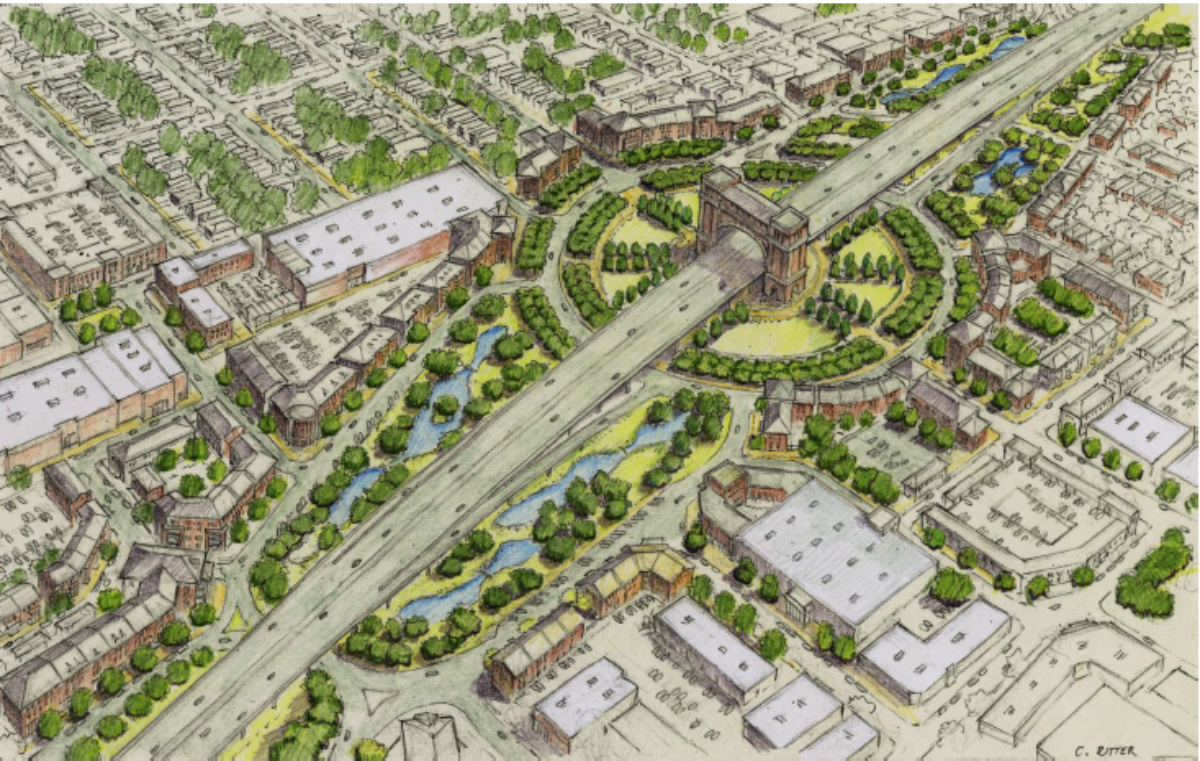 |
| Map of proposed I-49 Lafayette Connector freeway |
The group of people who are opposed to the I-49 Connector freeway project through Lafayette have always tended to build their case around an alternative alignment referred as the Teche Ridge Bypass, which would revert the proposed Interstate highway to the east of the center of Lafayette through St. Martin Parish, then reconnect with existing I-49 generally east of Carencro. Their argument has always been that Teche Ridge would be much cheaper, would avoid the displacements and divisions that the Connector alignment using the Evangeline Thruway/US 90 corridor would allegedly ensue, and could be built in “half the time” for “half the cost”.
With all respect to these people, who’s legitimate concerns about the impact of the Connector are worthy of addressing, I will show here why Teche Ridge is not as much a slam dunk solution to finishing I-49 through Lafayette. Indeed, a closer investigation will find that it is more of an airball.
First, a brief history summary lesson: In 1993, after the first I-49 Connector environmental study was terminated before a Final Environmental Impact Statement could be produced, the Lafayette Metropolitan Planning Organization (MPO, at that time called the Lafayette Areawide Planning Commission) paid for the Lafayette North-South Corridor Study, which analyzed 4 alternative corridors for completing I-49 through Lafayette. One circled around metro Lafayette to its west and south (Western Bypass); two bypassed Lafayette to the east (Eastern Bypass ran from just north of Carencro to near Breaux Bridge to link up with US 90 just north of Broussard; Eastern Alignment was similar to Eastern Bypass but shifted its connection to I-49 North to just south of Gloria Switch Road); and one used the Evangeline Thruway/US 90 corridor. A map of the LN/SCS alternatives studied appears below:
 |
| Corridors for Lafayette North-South Corridor Study (1993) Full report downloadable by clicking on link. |
That study concluded that the Evangeline Thruway corridor was still the most desirable and cost-efficient choice for extending I-49 due to environmental factors and traffic counts. Their analysis reported that since only 11% of traffic on the Thruway/US 90 corridor was traffic bypassing the city of Lafayette, a bypass would not attract or divert enough traffic from the central corridor to be cost effective; and there would also be enormous environmental impacts on wetlands and sensitive tributaries (such as Cypress Swamp and the Vermilion River).
It was soon after that study was released that opponents of the Connector decided to search for another east bypass alternative that would be more suitable for their needs; by 1994, it appeared that they had found it when the St. Martin Parish Police Jury contracted out the engineering firm of Baker and Associates to perform a “feasibility study” on a new bypass route. It was dubbed the “Teche Ridge Bypass” because it followed the Couteau-Teche Ridge that overlooks the Bayou Teche and Vermilion River basins; running between Cypress Swamp and Bayou Teche basin. A rendering of the proposed Teche Ridge Bypass taken from that study appears below:
 |
| An overview of the I-49 Teche Ridge Bypass alternative, from the Baker and Associates study. (via the I-49 Teche Ridge Facebook page) |
Since then, Connector opponents have been pushing Teche Ridge as the go-to “common sense” alternative to avoid the “mistakes” of building the Connector through “the heart of Lafayette”. Under actual analysis, however, their arguments turn out to be wishful thinking at best.
First off, let’s deal with the cost issue. Teche Ridge proponents are always pushing that their bypass will be significantly cheaper to construct than the Connector (or, as they derisively call the central alignment, “the Con”). The initial quote given by the St. Martin Parish study gave a raw total cost of $400 million for construction of the bypass; which would roughly compare to the estimate of $350 million quoted for construction of the 5.5 miles of the Connector from I-10 to just south of Lafayette Regional Airport. The section just south of the airport to the US 90/LA 88 interchange is covered by another project linked to the entire US 90 to I-49 South upgrade. That section had an projected cost of $350 million; which would make the combined cost of the overlapping portions of the central corridor $750 million. That would appear to justify the Teche Ridge advocates’ claim of their alignment being cheaper.
Or, so they think.
The group Concerned Citizens of Lafayette teamed up with the Greater Lafayette Sierra Club to file a lawsuit against the Louisiana Department of Transportation and Development (LADOTD) and the Federal Highway Administration (FHWA) to block implementation of the 2003 Record of Decision approving of the currently proposed I-49 Connector freeway alignment. In their lawsuit, they explicitly promoted the Teche Ridge Bypass as a superior alternative to the approved corridor, citing costs and less negative impacts. Part of their case came in the form of an affidavit that they sent to LADOTD as a elongated comment response to the Final Environmental Impact Statement (FEIS) that was released in October 2002 prior to final approval in the ROD. Here is one paragraph of Concerned Citizens’ affidavit where they defend Teche Ridge:
LADOTD, in their 2003 I-49 Connector ROD, offered this series of responses to the Concerned Citizens’ brief, which calls directly into question those arguments.




